Pic story of guardians of Hoh Xil in China's Qinghai

Staffers with the Drolkar Lake protection station of the Hoh Xil management office pose for group photos in Hoh Xil, northwest China's Qinghai Province, June 16, 2023. Located in Sanjiangyuan National Park, Hoh Xil is an important habitat for Tibetan antelopes which enjoy first-class state protection in China. Around May each year, tens of thousands of pregnant Tibetan antelopes start their migration to Hoh Xil to give birth, leaving with their offspring in late July. The Drolkar Lake area in Hoh Xil is a crucial birthplace of the species.
Renowned as one of the world's most breathtaking migrations of hoofed animals, this majestic journey of Tibetan antelopes has to confront with extreme weather and invasion of wild animals. Patrollers of Hoh Xil have been guarding Tibetan antelopes for decades.
Hoh Xil stands as China's largest world natural heritage site, maintaining a high-altitude ecosystem and iconic species of the Qinghai-Tibet Plateau. Since the establishment of Hoh Xil National Nature Reserve, six protection stations have been established one after another. In addition to working in shifts, batches of staffers also patrol deeply into the hinterland of the reserve from time to time. Small-scale patrol takes place once every three days while large-scale patrol takes place at least once a month. Up to now, three generations of patrollers have been guarding the land of Hoh Xil, which has become a landmark area for wildlife protection and ecological protection in China. The population of Tibetan antelopes in Hoh Xil has increased from less than 20,000 in the 1980s to over 70,000. (Xinhua/Zhang Hongxiang)
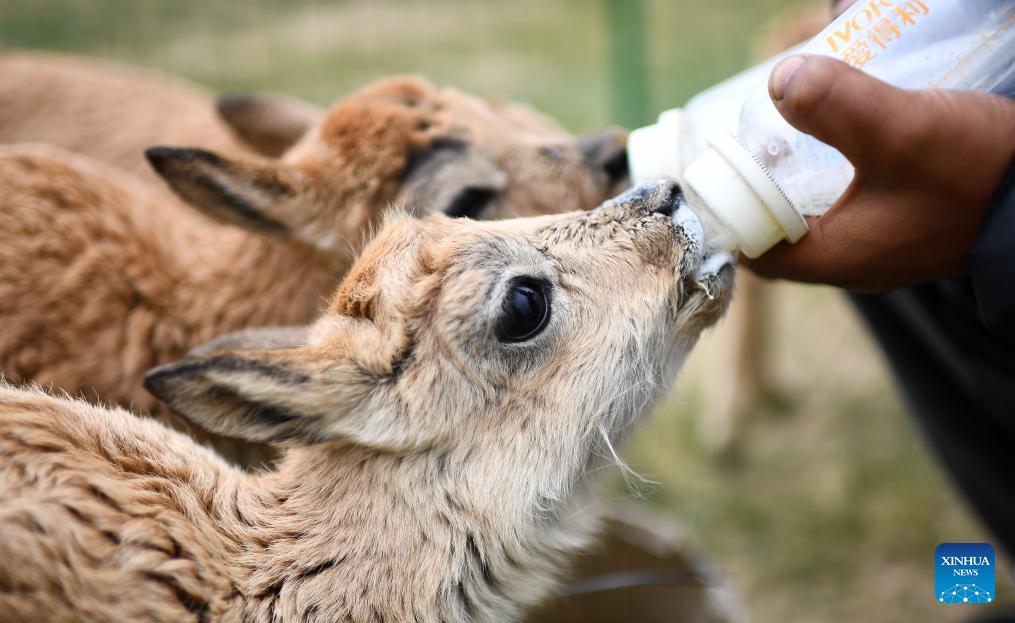
A staffer of the Hoh Xil management office feeds rescued Tibetan antelope calves in Hoh Xil, northwest China's Qinghai Province, July 28, 2023. Located in Sanjiangyuan National Park, Hoh Xil is an important habitat for Tibetan antelopes which enjoy first-class state protection in China. Around May each year, tens of thousands of pregnant Tibetan antelopes start their migration to Hoh Xil to give birth, leaving with their offspring in late July. The Drolkar Lake area in Hoh Xil is a crucial birthplace of the species.
Renowned as one of the world's most breathtaking migrations of hoofed animals, this majestic journey of Tibetan antelopes has to confront with extreme weather and invasion of wild animals. Patrollers of Hoh Xil have been guarding Tibetan antelopes for decades.
Hoh Xil stands as China's largest world natural heritage site, maintaining a high-altitude ecosystem and iconic species of the Qinghai-Tibet Plateau. Since the establishment of Hoh Xil National Nature Reserve, six protection stations have been established one after another. In addition to working in shifts, batches of staffers also patrol deeply into the hinterland of the reserve from time to time. Small-scale patrol takes place once every three days while large-scale patrol takes place at least once a month. Up to now, three generations of patrollers have been guarding the land of Hoh Xil, which has become a landmark area for wildlife protection and ecological protection in China. The population of Tibetan antelopes in Hoh Xil has increased from less than 20,000 in the 1980s to over 70,000. (Xinhua/Zhang Hongxiang)
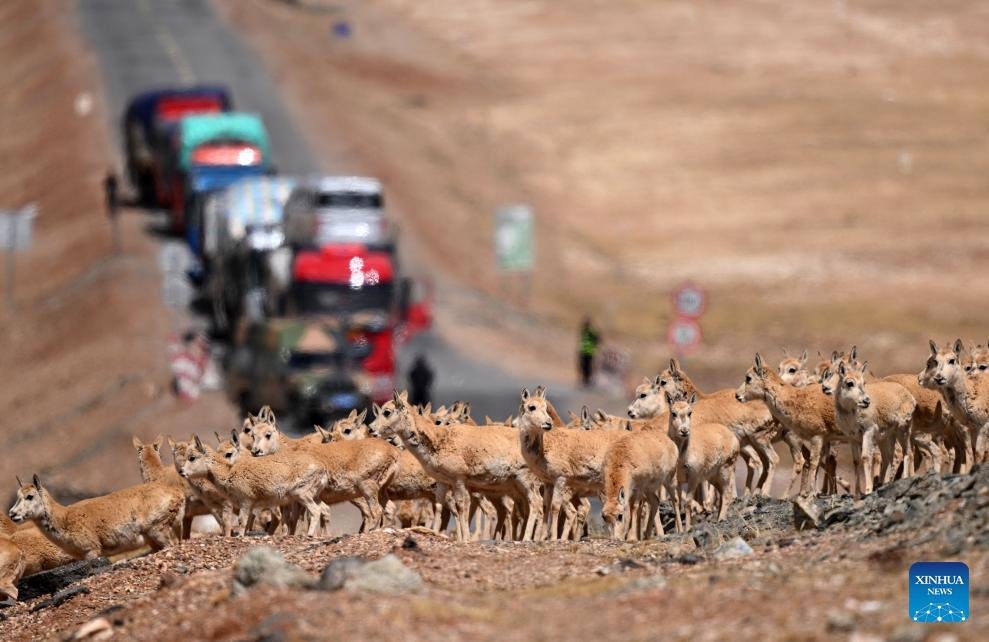
A group of pregnant Tibetan antelopes pass through the Qinghai-Tibet Highway and head towards the Drolkar Lake area in Hoh Xil, northwest China's Qinghai Province, May 29, 2023. Located in Sanjiangyuan National Park, Hoh Xil is an important habitat for Tibetan antelopes which enjoy first-class state protection in China. Around May each year, tens of thousands of pregnant Tibetan antelopes start their migration to Hoh Xil to give birth, leaving with their offspring in late July. The Drolkar Lake area in Hoh Xil is a crucial birthplace of the species.
Renowned as one of the world's most breathtaking migrations of hoofed animals, this majestic journey of Tibetan antelopes has to confront with extreme weather and invasion of wild animals. Patrollers of Hoh Xil have been guarding Tibetan antelopes for decades.
Hoh Xil stands as China's largest world natural heritage site, maintaining a high-altitude ecosystem and iconic species of the Qinghai-Tibet Plateau. Since the establishment of Hoh Xil National Nature Reserve, six protection stations have been established one after another. In addition to working in shifts, batches of staffers also patrol deeply into the hinterland of the reserve from time to time. Small-scale patrol takes place once every three days while large-scale patrol takes place at least once a month. Up to now, three generations of patrollers have been guarding the land of Hoh Xil, which has become a landmark area for wildlife protection and ecological protection in China. The population of Tibetan antelopes in Hoh Xil has increased from less than 20,000 in the 1980s to over 70,000. (Xinhua/Zhang Hongxiang)

A staffer with the Drolkar Lake protection station of the Hoh Xil management office encounters with heavy snowfall on the way to the Drolkar Lake protection station in Hoh Xil, northwest China's Qinghai Province, June 16, 2023. Located in Sanjiangyuan National Park, Hoh Xil is an important habitat for Tibetan antelopes which enjoy first-class state protection in China. Around May each year, tens of thousands of pregnant Tibetan antelopes start their migration to Hoh Xil to give birth, leaving with their offspring in late July. The Drolkar Lake area in Hoh Xil is a crucial birthplace of the species.
Renowned as one of the world's most breathtaking migrations of hoofed animals, this majestic journey of Tibetan antelopes has to confront with extreme weather and invasion of wild animals. Patrollers of Hoh Xil have been guarding Tibetan antelopes for decades.
Hoh Xil stands as China's largest world natural heritage site, maintaining a high-altitude ecosystem and iconic species of the Qinghai-Tibet Plateau. Since the establishment of Hoh Xil National Nature Reserve, six protection stations have been established one after another. In addition to working in shifts, batches of staffers also patrol deeply into the hinterland of the reserve from time to time. Small-scale patrol takes place once every three days while large-scale patrol takes place at least once a month. Up to now, three generations of patrollers have been guarding the land of Hoh Xil, which has become a landmark area for wildlife protection and ecological protection in China. The population of Tibetan antelopes in Hoh Xil has increased from less than 20,000 in the 1980s to over 70,000. (Xinhua/Zhang Hongxiang)
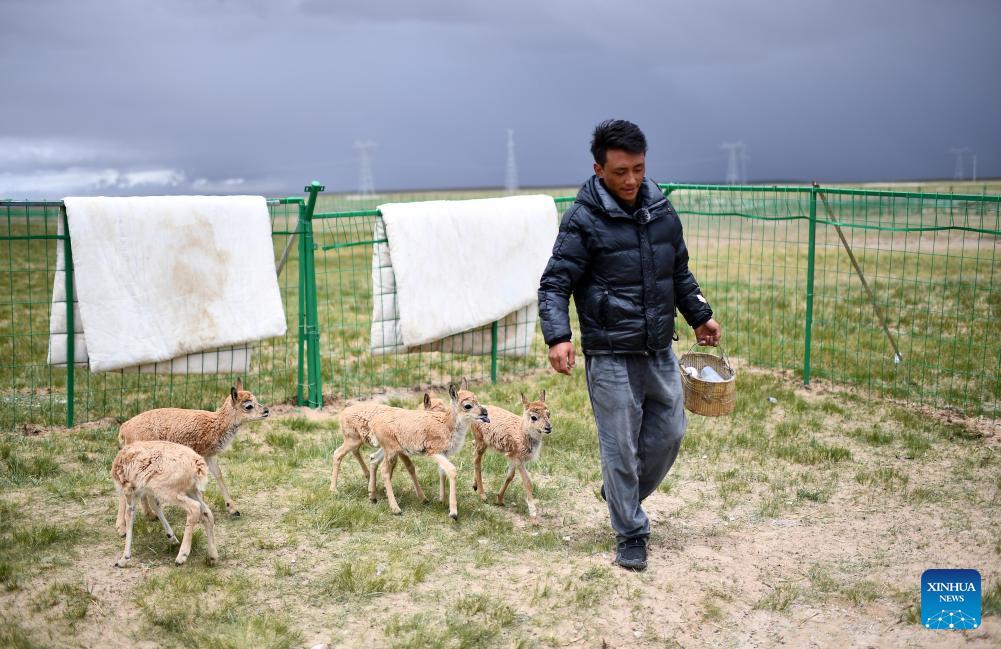
A staffer of the Hoh Xil management office is pictured with rescued Tibetan antelope calves in Hoh Xil, northwest China's Qinghai Province, July 28, 2023. Located in Sanjiangyuan National Park, Hoh Xil is an important habitat for Tibetan antelopes which enjoy first-class state protection in China. Around May each year, tens of thousands of pregnant Tibetan antelopes start their migration to Hoh Xil to give birth, leaving with their offspring in late July. The Drolkar Lake area in Hoh Xil is a crucial birthplace of the species.
Renowned as one of the world's most breathtaking migrations of hoofed animals, this majestic journey of Tibetan antelopes has to confront with extreme weather and invasion of wild animals. Patrollers of Hoh Xil have been guarding Tibetan antelopes for decades.
Hoh Xil stands as China's largest world natural heritage site, maintaining a high-altitude ecosystem and iconic species of the Qinghai-Tibet Plateau. Since the establishment of Hoh Xil National Nature Reserve, six protection stations have been established one after another. In addition to working in shifts, batches of staffers also patrol deeply into the hinterland of the reserve from time to time. Small-scale patrol takes place once every three days while large-scale patrol takes place at least once a month. Up to now, three generations of patrollers have been guarding the land of Hoh Xil, which has become a landmark area for wildlife protection and ecological protection in China. The population of Tibetan antelopes in Hoh Xil has increased from less than 20,000 in the 1980s to over 70,000. (Xinhua/Zhang Hongxiang)

Guo Xuehu, deputy head of the preservation station of Drolkar Lake, poses for photos at the Drolkar Lake protection station in Hoh Xil, northwest China's Qinghai Province, June 17, 2023. Located in Sanjiangyuan National Park, Hoh Xil is an important habitat for Tibetan antelopes which enjoy first-class state protection in China. Around May each year, tens of thousands of pregnant Tibetan antelopes start their migration to Hoh Xil to give birth, leaving with their offspring in late July. The Drolkar Lake area in Hoh Xil is a crucial birthplace of the species.
Renowned as one of the world's most breathtaking migrations of hoofed animals, this majestic journey of Tibetan antelopes has to confront with extreme weather and invasion of wild animals. Patrollers of Hoh Xil have been guarding Tibetan antelopes for decades.
Hoh Xil stands as China's largest world natural heritage site, maintaining a high-altitude ecosystem and iconic species of the Qinghai-Tibet Plateau. Since the establishment of Hoh Xil National Nature Reserve, six protection stations have been established one after another. In addition to working in shifts, batches of staffers also patrol deeply into the hinterland of the reserve from time to time. Small-scale patrol takes place once every three days while large-scale patrol takes place at least once a month. Up to now, three generations of patrollers have been guarding the land of Hoh Xil, which has become a landmark area for wildlife protection and ecological protection in China. The population of Tibetan antelopes in Hoh Xil has increased from less than 20,000 in the 1980s to over 70,000. (Xinhua/Zhang Hongxiang)
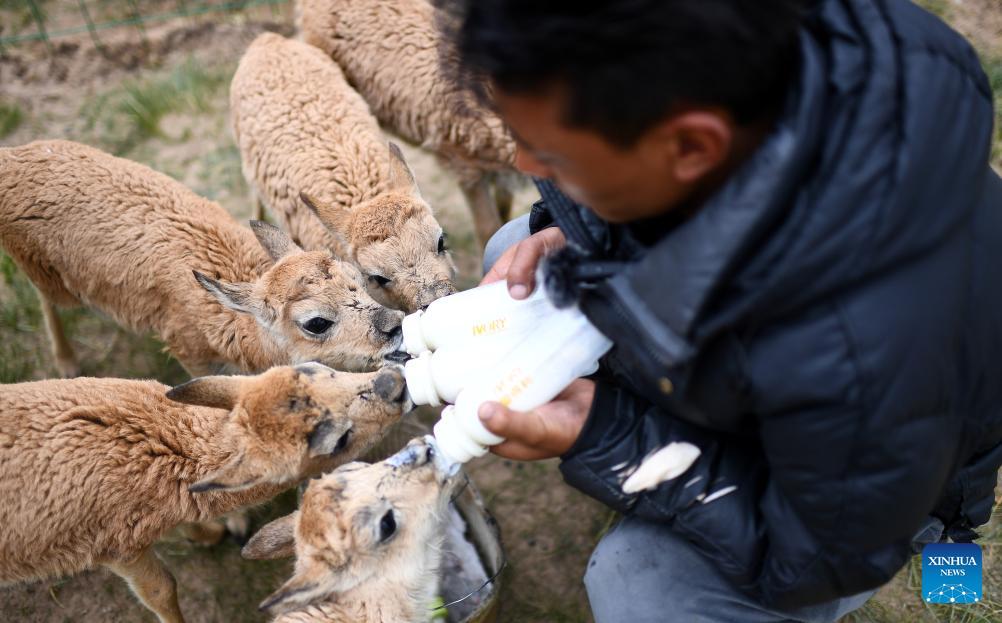
A staffer of the Hoh Xil management office feeds rescued Tibetan antelope calves in Hoh Xil, northwest China's Qinghai Province, July 28, 2023. Located in Sanjiangyuan National Park, Hoh Xil is an important habitat for Tibetan antelopes which enjoy first-class state protection in China. Around May each year, tens of thousands of pregnant Tibetan antelopes start their migration to Hoh Xil to give birth, leaving with their offspring in late July. The Drolkar Lake area in Hoh Xil is a crucial birthplace of the species.
Renowned as one of the world's most breathtaking migrations of hoofed animals, this majestic journey of Tibetan antelopes has to confront with extreme weather and invasion of wild animals. Patrollers of Hoh Xil have been guarding Tibetan antelopes for decades.
Hoh Xil stands as China's largest world natural heritage site, maintaining a high-altitude ecosystem and iconic species of the Qinghai-Tibet Plateau. Since the establishment of Hoh Xil National Nature Reserve, six protection stations have been established one after another. In addition to working in shifts, batches of staffers also patrol deeply into the hinterland of the reserve from time to time. Small-scale patrol takes place once every three days while large-scale patrol takes place at least once a month. Up to now, three generations of patrollers have been guarding the land of Hoh Xil, which has become a landmark area for wildlife protection and ecological protection in China. The population of Tibetan antelopes in Hoh Xil has increased from less than 20,000 in the 1980s to over 70,000. (Xinhua/Zhang Hongxiang)
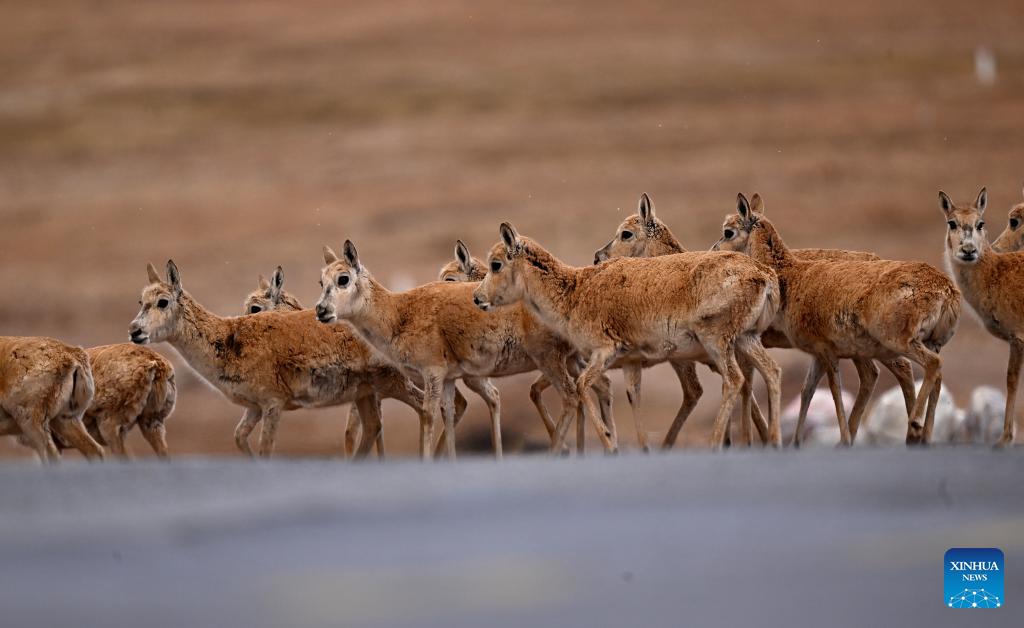
A group of pregnant Tibetan antelopes pass through the Qinghai-Tibet Highway and head towards the Drolkar Lake area in Hoh Xil, northwest China's Qinghai Province, May 28, 2023. Located in Sanjiangyuan National Park, Hoh Xil is an important habitat for Tibetan antelopes which enjoy first-class state protection in China. Around May each year, tens of thousands of pregnant Tibetan antelopes start their migration to Hoh Xil to give birth, leaving with their offspring in late July. The Drolkar Lake area in Hoh Xil is a crucial birthplace of the species.
Renowned as one of the world's most breathtaking migrations of hoofed animals, this majestic journey of Tibetan antelopes has to confront with extreme weather and invasion of wild animals. Patrollers of Hoh Xil have been guarding Tibetan antelopes for decades.
Hoh Xil stands as China's largest world natural heritage site, maintaining a high-altitude ecosystem and iconic species of the Qinghai-Tibet Plateau. Since the establishment of Hoh Xil National Nature Reserve, six protection stations have been established one after another. In addition to working in shifts, batches of staffers also patrol deeply into the hinterland of the reserve from time to time. Small-scale patrol takes place once every three days while large-scale patrol takes place at least once a month. Up to now, three generations of patrollers have been guarding the land of Hoh Xil, which has become a landmark area for wildlife protection and ecological protection in China. The population of Tibetan antelopes in Hoh Xil has increased from less than 20,000 in the 1980s to over 70,000. (Xinhua/Zhang Hongxiang)
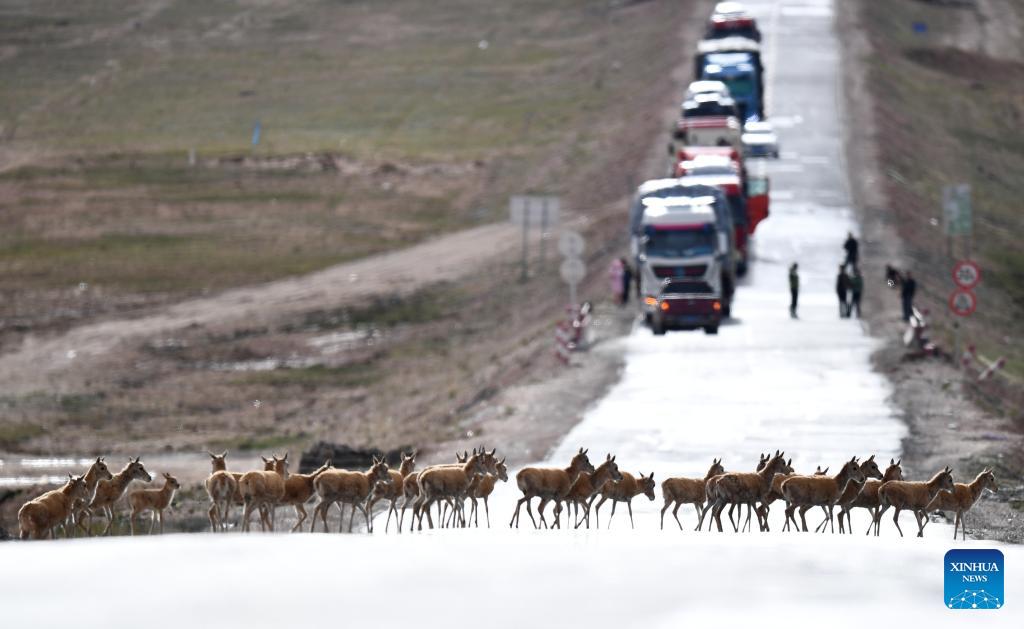
A group of Tibetan antelopes pass through the Qinghai-Tibet Highway and head towards the Sanjiangyuan area in northwest China's Qinghai Province, July 28, 2023. Located in Sanjiangyuan National Park, Hoh Xil is an important habitat for Tibetan antelopes which enjoy first-class state protection in China. Around May each year, tens of thousands of pregnant Tibetan antelopes start their migration to Hoh Xil to give birth, leaving with their offspring in late July. The Drolkar Lake area in Hoh Xil is a crucial birthplace of the species.
Renowned as one of the world's most breathtaking migrations of hoofed animals, this majestic journey of Tibetan antelopes has to confront with extreme weather and invasion of wild animals. Patrollers of Hoh Xil have been guarding Tibetan antelopes for decades.
Hoh Xil stands as China's largest world natural heritage site, maintaining a high-altitude ecosystem and iconic species of the Qinghai-Tibet Plateau. Since the establishment of Hoh Xil National Nature Reserve, six protection stations have been established one after another. In addition to working in shifts, batches of staffers also patrol deeply into the hinterland of the reserve from time to time. Small-scale patrol takes place once every three days while large-scale patrol takes place at least once a month. Up to now, three generations of patrollers have been guarding the land of Hoh Xil, which has become a landmark area for wildlife protection and ecological protection in China. The population of Tibetan antelopes in Hoh Xil has increased from less than 20,000 in the 1980s to over 70,000. (Xinhua/Zhang Hongxiang)
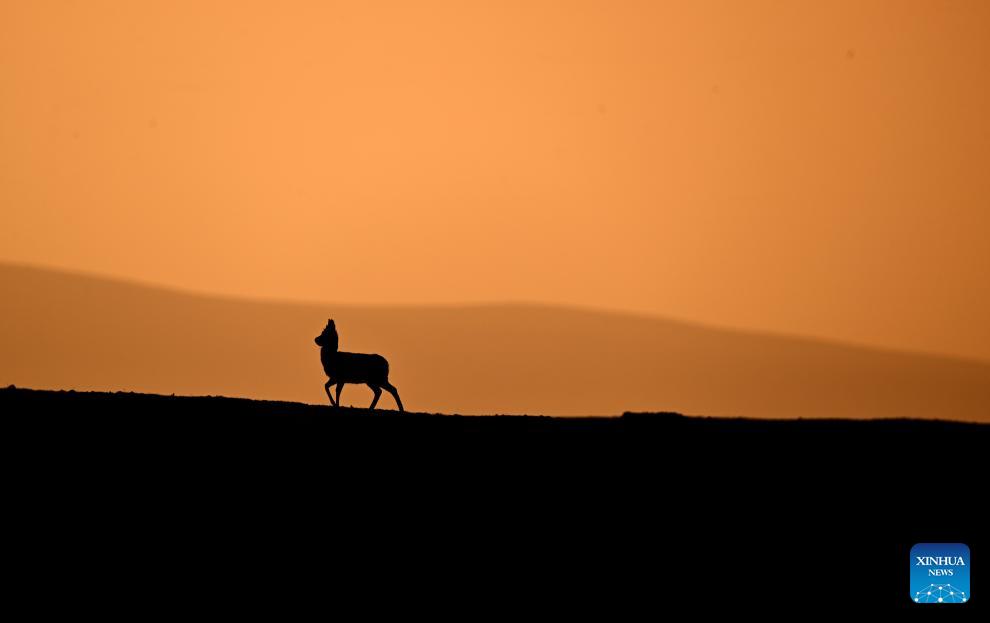
A female Tibetan antelope is pictured at the Drolkar Lake area in Hoh Xil, northwest China's Qinghai Province, June 18, 2023. Located in Sanjiangyuan National Park, Hoh Xil is an important habitat for Tibetan antelopes which enjoy first-class state protection in China. Around May each year, tens of thousands of pregnant Tibetan antelopes start their migration to Hoh Xil to give birth, leaving with their offspring in late July. The Drolkar Lake area in Hoh Xil is a crucial birthplace of the species.
Renowned as one of the world's most breathtaking migrations of hoofed animals, this majestic journey of Tibetan antelopes has to confront with extreme weather and invasion of wild animals. Patrollers of Hoh Xil have been guarding Tibetan antelopes for decades.
Hoh Xil stands as China's largest world natural heritage site, maintaining a high-altitude ecosystem and iconic species of the Qinghai-Tibet Plateau. Since the establishment of Hoh Xil National Nature Reserve, six protection stations have been established one after another. In addition to working in shifts, batches of staffers also patrol deeply into the hinterland of the reserve from time to time. Small-scale patrol takes place once every three days while large-scale patrol takes place at least once a month. Up to now, three generations of patrollers have been guarding the land of Hoh Xil, which has become a landmark area for wildlife protection and ecological protection in China. The population of Tibetan antelopes in Hoh Xil has increased from less than 20,000 in the 1980s to over 70,000. (Xinhua/Zhang Hongxiang)
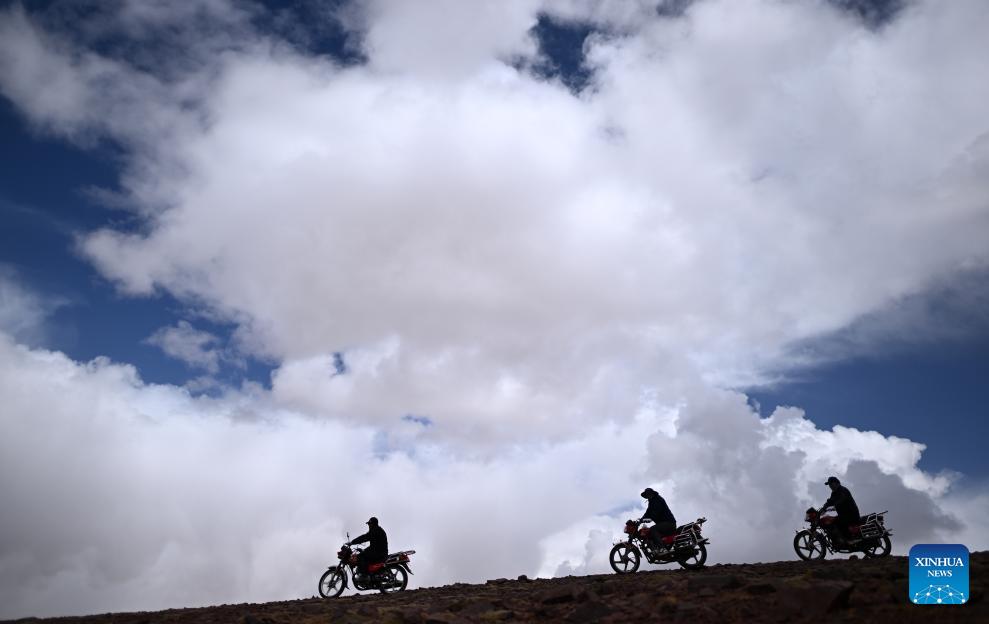
Staffers with the Drolkar Lake protection station of the Hoh Xil management office patrol around the Drolkar Lake area in Hoh Xil, northwest China's Qinghai Province, June 17, 2023. Located in Sanjiangyuan National Park, Hoh Xil is an important habitat for Tibetan antelopes which enjoy first-class state protection in China. Around May each year, tens of thousands of pregnant Tibetan antelopes start their migration to Hoh Xil to give birth, leaving with their offspring in late July. The Drolkar Lake area in Hoh Xil is a crucial birthplace of the species.
Renowned as one of the world's most breathtaking migrations of hoofed animals, this majestic journey of Tibetan antelopes has to confront with extreme weather and invasion of wild animals. Patrollers of Hoh Xil have been guarding Tibetan antelopes for decades.
Hoh Xil stands as China's largest world natural heritage site, maintaining a high-altitude ecosystem and iconic species of the Qinghai-Tibet Plateau. Since the establishment of Hoh Xil National Nature Reserve, six protection stations have been established one after another. In addition to working in shifts, batches of staffers also patrol deeply into the hinterland of the reserve from time to time. Small-scale patrol takes place once every three days while large-scale patrol takes place at least once a month. Up to now, three generations of patrollers have been guarding the land of Hoh Xil, which has become a landmark area for wildlife protection and ecological protection in China. The population of Tibetan antelopes in Hoh Xil has increased from less than 20,000 in the 1980s to over 70,000. (Xinhua/Zhang Hongxiang)

Tsesogyal (L), a staffer with the Drolkar Lake protection station, and his colleague repair a vehicle on their way to the Drolkar Lake protection station in Hoh Xil, northwest China's Qinghai Province, June 16, 2023. Located in Sanjiangyuan National Park, Hoh Xil is an important habitat for Tibetan antelopes which enjoy first-class state protection in China. Around May each year, tens of thousands of pregnant Tibetan antelopes start their migration to Hoh Xil to give birth, leaving with their offspring in late July. The Drolkar Lake area in Hoh Xil is a crucial birthplace of the species.
Renowned as one of the world's most breathtaking migrations of hoofed animals, this majestic journey of Tibetan antelopes has to confront with extreme weather and invasion of wild animals. Patrollers of Hoh Xil have been guarding Tibetan antelopes for decades.
Hoh Xil stands as China's largest world natural heritage site, maintaining a high-altitude ecosystem and iconic species of the Qinghai-Tibet Plateau. Since the establishment of Hoh Xil National Nature Reserve, six protection stations have been established one after another. In addition to working in shifts, batches of staffers also patrol deeply into the hinterland of the reserve from time to time. Small-scale patrol takes place once every three days while large-scale patrol takes place at least once a month. Up to now, three generations of patrollers have been guarding the land of Hoh Xil, which has become a landmark area for wildlife protection and ecological protection in China. The population of Tibetan antelopes in Hoh Xil has increased from less than 20,000 in the 1980s to over 70,000. (Xinhua/Zhang Hongxiang)

A staffer with the Drolkar Lake protection station of the Hoh Xil management office prepares to perform rescue operation on trapped vehicles in Hoh Xil, northwest China's Qinghai Province, June 16, 2023. Located in Sanjiangyuan National Park, Hoh Xil is an important habitat for Tibetan antelopes which enjoy first-class state protection in China. Around May each year, tens of thousands of pregnant Tibetan antelopes start their migration to Hoh Xil to give birth, leaving with their offspring in late July. The Drolkar Lake area in Hoh Xil is a crucial birthplace of the species.
Renowned as one of the world's most breathtaking migrations of hoofed animals, this majestic journey of Tibetan antelopes has to confront with extreme weather and invasion of wild animals. Patrollers of Hoh Xil have been guarding Tibetan antelopes for decades.
Hoh Xil stands as China's largest world natural heritage site, maintaining a high-altitude ecosystem and iconic species of the Qinghai-Tibet Plateau. Since the establishment of Hoh Xil National Nature Reserve, six protection stations have been established one after another. In addition to working in shifts, batches of staffers also patrol deeply into the hinterland of the reserve from time to time. Small-scale patrol takes place once every three days while large-scale patrol takes place at least once a month. Up to now, three generations of patrollers have been guarding the land of Hoh Xil, which has become a landmark area for wildlife protection and ecological protection in China. The population of Tibetan antelopes in Hoh Xil has increased from less than 20,000 in the 1980s to over 70,000. (Xinhua/Zhang Hongxiang)

This aerial photo taken on June 17, 2023 shows a view of the Drolkar Lake protection station of the Hoh Xil management office in Hoh Xil, northwest China's Qinghai Province. Located in Sanjiangyuan National Park, Hoh Xil is an important habitat for Tibetan antelopes which enjoy first-class state protection in China. Around May each year, tens of thousands of pregnant Tibetan antelopes start their migration to Hoh Xil to give birth, leaving with their offspring in late July. The Drolkar Lake area in Hoh Xil is a crucial birthplace of the species.
Renowned as one of the world's most breathtaking migrations of hoofed animals, this majestic journey of Tibetan antelopes has to confront with extreme weather and invasion of wild animals. Patrollers of Hoh Xil have been guarding Tibetan antelopes for decades.
Hoh Xil stands as China's largest world natural heritage site, maintaining a high-altitude ecosystem and iconic species of the Qinghai-Tibet Plateau. Since the establishment of Hoh Xil National Nature Reserve, six protection stations have been established one after another. In addition to working in shifts, batches of staffers also patrol deeply into the hinterland of the reserve from time to time. Small-scale patrol takes place once every three days while large-scale patrol takes place at least once a month. Up to now, three generations of patrollers have been guarding the land of Hoh Xil, which has become a landmark area for wildlife protection and ecological protection in China. The population of Tibetan antelopes in Hoh Xil has increased from less than 20,000 in the 1980s to over 70,000. (Xinhua/Zhang Hongxiang)

Tibetan antelopes are pictured at the Drolkar Lake area in Hoh Xil, northwest China's Qinghai Province, June 18, 2023. Located in Sanjiangyuan National Park, Hoh Xil is an important habitat for Tibetan antelopes which enjoy first-class state protection in China. Around May each year, tens of thousands of pregnant Tibetan antelopes start their migration to Hoh Xil to give birth, leaving with their offspring in late July. The Drolkar Lake area in Hoh Xil is a crucial birthplace of the species.
Renowned as one of the world's most breathtaking migrations of hoofed animals, this majestic journey of Tibetan antelopes has to confront with extreme weather and invasion of wild animals. Patrollers of Hoh Xil have been guarding Tibetan antelopes for decades.
Hoh Xil stands as China's largest world natural heritage site, maintaining a high-altitude ecosystem and iconic species of the Qinghai-Tibet Plateau. Since the establishment of Hoh Xil National Nature Reserve, six protection stations have been established one after another. In addition to working in shifts, batches of staffers also patrol deeply into the hinterland of the reserve from time to time. Small-scale patrol takes place once every three days while large-scale patrol takes place at least once a month. Up to now, three generations of patrollers have been guarding the land of Hoh Xil, which has become a landmark area for wildlife protection and ecological protection in China. The population of Tibetan antelopes in Hoh Xil has increased from less than 20,000 in the 1980s to over 70,000. (Xinhua/Zhang Hongxiang)
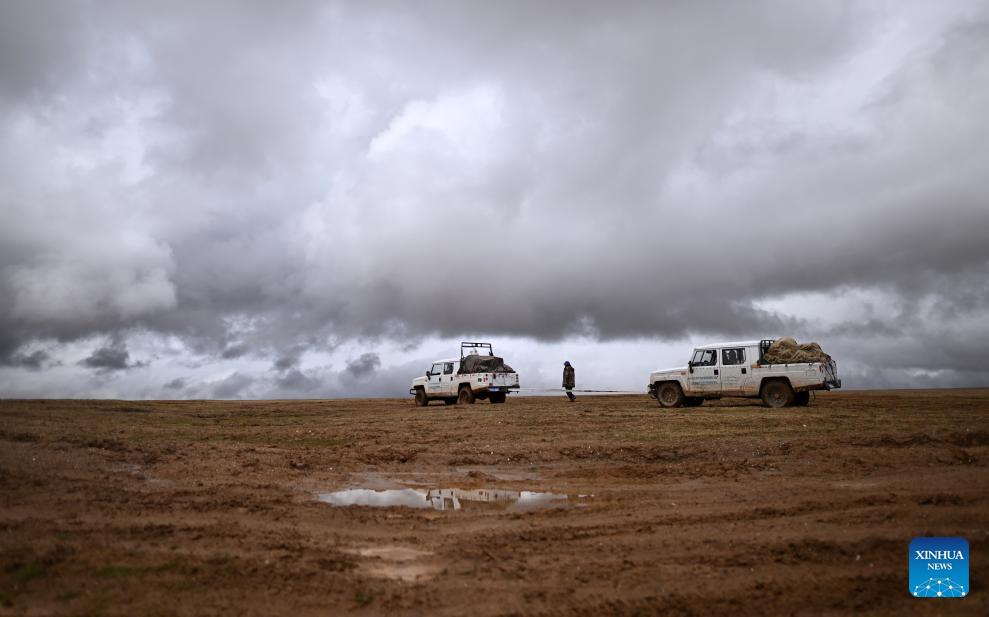
A staffer with the Drolkar Lake protection station of the Hoh Xil management office checks the condition of trapped vehicles in Hoh Xil, northwest China's Qinghai Province, June 16, 2023. Located in Sanjiangyuan National Park, Hoh Xil is an important habitat for Tibetan antelopes which enjoy first-class state protection in China. Around May each year, tens of thousands of pregnant Tibetan antelopes start their migration to Hoh Xil to give birth, leaving with their offspring in late July. The Drolkar Lake area in Hoh Xil is a crucial birthplace of the species.
Renowned as one of the world's most breathtaking migrations of hoofed animals, this majestic journey of Tibetan antelopes has to confront with extreme weather and invasion of wild animals. Patrollers of Hoh Xil have been guarding Tibetan antelopes for decades.
Hoh Xil stands as China's largest world natural heritage site, maintaining a high-altitude ecosystem and iconic species of the Qinghai-Tibet Plateau. Since the establishment of Hoh Xil National Nature Reserve, six protection stations have been established one after another. In addition to working in shifts, batches of staffers also patrol deeply into the hinterland of the reserve from time to time. Small-scale patrol takes place once every three days while large-scale patrol takes place at least once a month. Up to now, three generations of patrollers have been guarding the land of Hoh Xil, which has become a landmark area for wildlife protection and ecological protection in China. The population of Tibetan antelopes in Hoh Xil has increased from less than 20,000 in the 1980s to over 70,000. (Xinhua/Zhang Hongxiang)
